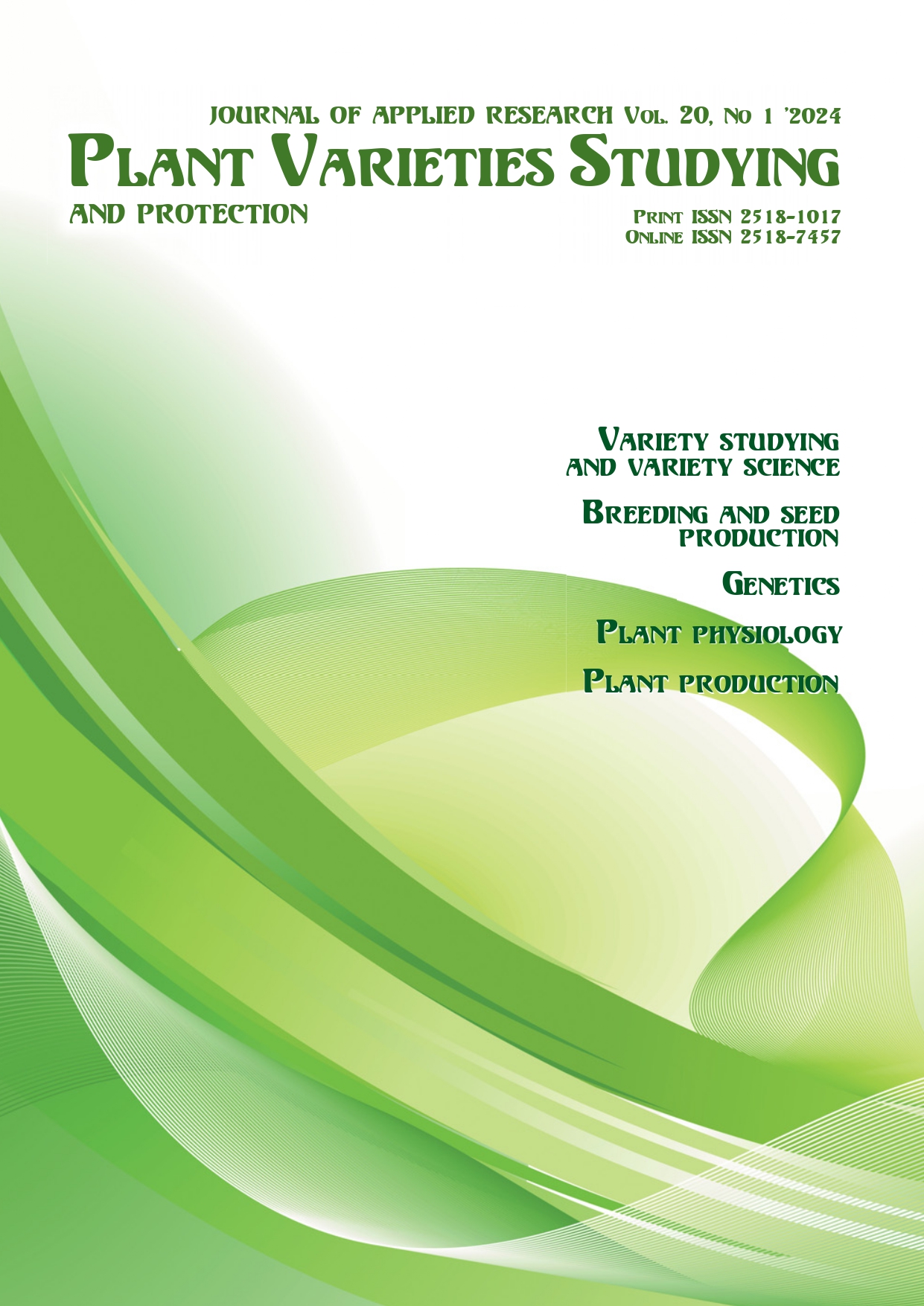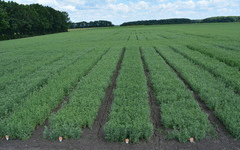Selection evaluation of new selfpollinated sunflower (Helianthus annuus L.) lines with resistance to sulfonylurea herbicides and downy mildew [Plasmopara halstedii (Farl.) Berl. et. de Tony]
DOI:
https://doi.org/10.21498/2518-1017.20.1.2024.300134Keywords:
sunflower, lines, resistant, herbicides, tribenuronmethyl, downy mildewAbstract
Purpose. To determine the breeding value of a new sunflower source with complex resistance to sulfonylurea herbicides and downy mildew. Methods. In the research process, field (hybridization, line testing, individual selection, line evaluation), visual (phenological observations), laboratory (immunological evaluation of resistance to DM), vegetation (evaluation of resistance to herbicides) and mathematical and statistical (processing of experimental data and determination of reliability of research results) methods were used. Results. During 2020–2023, new selfpollinated sunflower lines were studied in the crosspollination and breeding department of the Plant Breeding & Genetics Institute – National Center of Seeds and Cultivar Investigation (PBGI – NCSCI). Based on the results of the work, 33 selfpollinated sunflower lines with complex resistance to sulfonylurea herbicides and downy mildew (DM) were created and evaluated. The lines were created using domestic breeding populations that were able to reach their full genetic potential in various conditions. These populations were adapted to cultivation in the southern steppe of Ukraine and were resistant to a complex of diseases and pests. Additionally, they had increased seed yield and plasticity. The new source material obtained is constant, stably productive lines used in the subsequent breeding programme. According to the results of the trials, almost all the hybrids obtained (F1) showed a yield of more than 1.0 t/ha. Lines with the highest level of combining ability in terms of yield (heterozygous hybrid progeny with increased viability for the main economic and valuable traits) will be selected for further research and will be involved in the creation of new hybrids resistant to sulfonylurea herbicides and DM. Conclusions. Research showed that traits such as sulfonylurea herbicide resistance and downy mildew resistance can be combined in one line. Herbicide resistance in sunflowers is easy to control in the field, while downy mildew resistance needs to be controlled in the laboratory.
Downloads
References
Mazur, S., & Matusevych, H. (2023). Influence of soil herbicides on biometric indicators and yield of sunflower. Balanced Natue Using, 1, 90–96. doi: 10.33730/2310-4678.1.2023.278544 [In Ukrainian]
Gutyansky, R., Popov, S., Kostromitin, V., Kuzmenko, N., & Gluboky, O. (2021). The influence of basic tillage and fertilizer on weediness of sunflower crops. Ukrainian Black Sea Region Agrarian Science, 1, 60–68. doi: 10.31521/2313-092X/2021-1(109)-8 [In Ukrainian]
Rauf, S. (2019). Breeding strategies for sunflower (Helianthus annuus L.) genetic improvement. Advances in Plant Breeding Strategies: Industrial and Food Crops, 6, 637673. doi: 10.1007/978-3-030-23265-8_16
Krivenko, A. I., Pochkolina, S. V., & Bezedi, N. G. (2019). Weeds Species in winter wheat crops depending on predecessors and different systems of basic cultivation in the Black Sea Steppe Region. Taurian Scientific Herald, 108, 54–62. doi: 10.32851/2226-0099.2019.108.8 [In Ukrainian]
Tan, S., Evans, R. R., Dahmer, M. L., Singh, B. K., & Shaner, D. L. (2005). Imidazolinone tolerant crops: history, current status and future. Pest Management Science, 61(3), 246–257. doi: 10.1002/ps.993

Dicu, G., Dumitrescu, N., Radu, M., Fuia, S., & Diaconescu, O. (2009). Improving sunflower for resistance to Orobanche and tribenuron methyl herbicidessunflower hybrid PF100. Helia, 32(51), 119–125. doi: 10.2298/HEL0951119D
Mitkov, A., Yanev, M., Neshev, N., Tonev T., JoiţaPăcureanu, M., & Cojocaru, F. (2019). Efficacy against broomrape and selectivity of imazamoxcontaining herbicides in sunflower. Romanian Agricultural Research, 36, 201–207. doi: 10.59665/rar3623
Atlagić, J., & Terzić, S. (2016). The challenges of maintaining a collection of wild sunflower (Helianthus) species. Genetic Resources and Crop Evolution, 63(7), 1219–1236. doi: 10.1007/s10722-015-0313-8
Seiler, G., Gulya, T., & Marek, L. (2023). Fifty years of collecting wild Helianthus species for cultivated sunflower improvement. Helia, 46(78), 1–51. doi: 10.1515/helia-2023-0003
Koleshkova, T. N., Riabchun, V. K., Leonova, N. M., Leonov, O. Yu., Kuzmishina, N. V., Suprun, O. H., Ilchenko, N. K., & Sheliakina, T. A. (2016). Formation of a working collection of sunflower variets by protein and oil contents in seeds. Plant Genetic Resources, 19, 102-117 [In Ukrainian]
AlKhatib, K., & Miller, J. F. (2000). Registration of four genetic stocks of sunflower resistant to imidazolinone herbicides. Crop Science, 40(3), Article 869.
Miller, J. F., & AlKhatib, К. (2004). Registration of two oilseed sunflower genetic stocks, SURES1 and SURES2 resistant to tribenuron herbicide. Crop Science, 44(3), 1037–1039. doi: 10.2135/cropsci2004.1037
MolineroRuiz, L. (2022). Sustainable and efficient control of sunflower downy mildew by means of genetic resistance: a review. Theoretical and Applied Genetics, 135(1), 3757–3771. doi: 10.1007/s00122-022-04038-7

Bаn, R., Kiss, J., Pаlinkаs, Z., & Körösi, K. (2023). Placing Management of Sunflower Downy Mildew (Plasmopara halstedii (Farl.) Berl. et de Toni) under an Integrated Pest Management (IPM) System Approach: Challenges and New Perspectives. Agronomy, 13(4), Article 1029. doi: 10.3390/agronomy13041029
Firestone, D. (Ed.). (1998). Official methods and recommended practices of the American Oil Chemists’ Society (5th ed.). Champaign: AOCS Press.
Jocić, S., Malidža, G., Cvejić, S., Hladni, N., Miklič, V., & Škorić, D. (2011). Development of sunflower hybrids tolerant to tribenuronmethyl. Genetika, 43(1), 175–182. doi: 10.2298/GENSR1101175J
Solodenko, A. Ye., Fayt, V. I., Christodorova, К. М., & Varenyk, B. F. (2017). Using of DNA markers of gene PlARG while creating of resistant to downy mildew sunflower (Helianthus annuus L.) inbred lines. Collected Scientific Articles of PBGI – NCSCI, 30, 53–60 [In Ukrainian]
Solodenko, A. Ye., Varenyk, B. F., Alexandrova, O. Ye., & Syvolap, Yu. M. (2013). Downy mildew race composition and definition of resistance of sunflower lines. Collected Scientific Articles of PBGI – NCSCI, 22, 134–140 [In Ukrainian]
Picard, C., Afonso, T., BenkoBeloglavec, A., Karadjova, O., MatthewsBerry, S., Paunovic, S. A., … Ward, M. (2018). Recommended regulated nonquarantine pests (RNQPs), associated thresholds and risk management measures in the European and Mediterranean region. EPPO Bulletin, 48(3), 552–568. doi: 10.1111/epp.12500
Kutishcheva, N. M., Shugurova, N. O., Krasnokutska, Y. V., Odinets, S. I., & Shudria, L. I. (2023). Scientific and applied aspects of sunflower breeding for the pathogen complex. Scientific & Technical Bulletin of the Institute of Oilseed Crops NAAS, 35, 40–50. doi: 10.36710/IOC2023-35-04 [In Ukrainian]
Downloads
Published
How to Cite
Issue
Section
License
Copyright (c) 2024 A. S. Ilchenko, B. F. Varenyk, S. I. Karapira

This work is licensed under a Creative Commons Attribution-ShareAlike 4.0 International License.
Starting in 2022, the copyright to the publication remains with the authors
Our journal abides by the CREATIVE COMMONS copyright rights and permissions for open access journals.
Authors, who are published in this journal, agree to the following conditions:
- The authors reserve the right to authorship of the work and pass the first publication right of this work to the journal under the terms of a Creative Commons Attribution License, which allows others to freely distribute the published research with the obligatory reference to the authors of the original work and the first publication of the work in this journal.
- The authors have the right to conclude separate supplement agreements that relate to non-exclusive work distribution in the form in which it has been published by the journal (for example, to upload the work to the online storage of the journal or publish it as part of a monograph), provided that the reference to the first publication of the work in this journal is included.

























 Ukrainian Institute for Plant Varieties Examination
Ukrainian Institute for Plant Varieties Examination  Селекційно-генетичний інститут
Селекційно-генетичний інститут Institute of Plant Physiology and Genetics of the National Academy of Sciences of Ukraine
Institute of Plant Physiology and Genetics of the National Academy of Sciences of Ukraine
 The National Academy of Agrarian Sciences of Ukraine
The National Academy of Agrarian Sciences of Ukraine